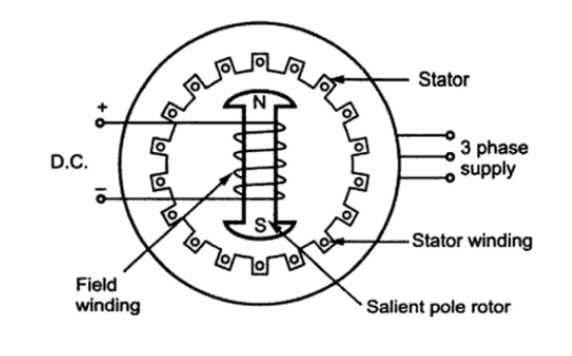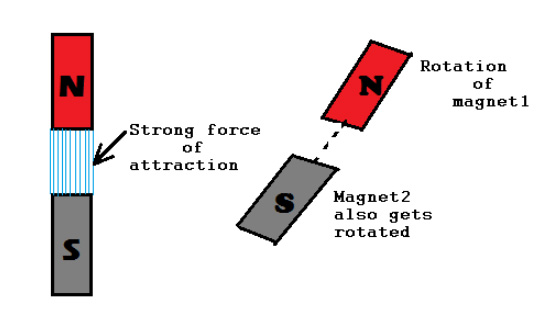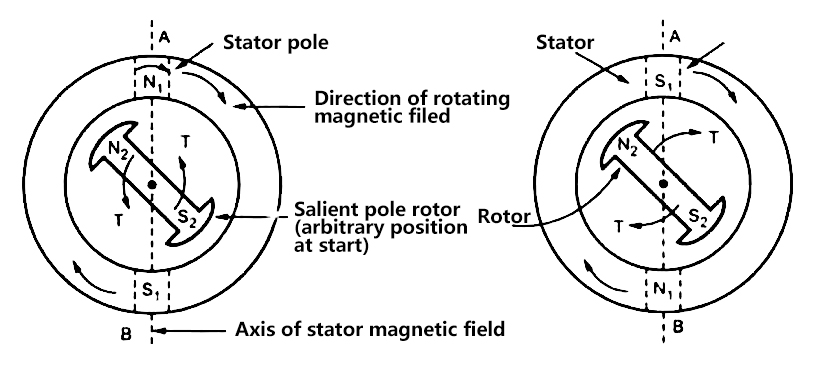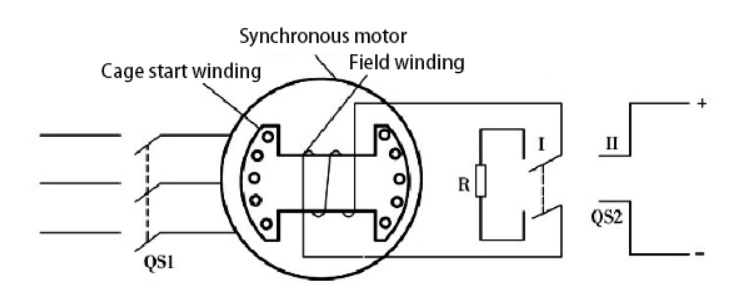How Does a Synchronous Motor Work?
A synchronous motor is an AC motor in which the rotation of the rotor is synchronized with the frequency of the supply current. That is, the period of rotation of the rotor is equal to the rotating magnetic field of the machine in which it is placed. In this article, we will introduce synchronous motor working principle.
Two Parts of Synchronous Motor:
- Rotor. Rotor is a field winding. The field winding is excited by the separate D.C supply through the slip ring. The construction of rotor can be divided into projected pole and cylindrical pole type.
- Stator. Stator is the armature winding. It consists of three phase star connected winding and excited by three phase AC power source.
Magnetic Locking in Synchronous Motor:
The working principle of synchronous motor is magnetic lock. When two different magnetic poles meet, a huge pull-off force is created between the two magnetic poles. In this case, the two magnets are called magnetic locks. If now one of the two magnets is spinning, the other magnets are spinning at the same speed and in the same direction due to the strong gravitational pull.

In a magnetic lock condition, there must be two different magnetic poles, and the magnetic axes of the two magnetic poles must be very close. Consider a 12V synchronous motor whose stator windings are two poles. The stator winding adopts three-phase AC excitation, and the rotor winding adopts DC excitation. Therefore, two magnetic fields are generated in the synchronous motor. When a three-phase winding is powered by a three-phase AC power source, a rotating magnetic field or flux is generated. This magnetic field or flux rotates in a space at a speed called synchronous speed.
The stator winding has a similar number of poles to the rotor winding, and is powered by a three phase AC power supply. A three phase AC power source generates a rotating magnetic field in the stator. The rotor windings are powered by a DC power source, which magnetizes the rotor. Consider the bipolar synchronous motor shown in the figure below.
Now, the stator poles rotate at synchronous speed (assuming clockwise). If the rotor position is such that the N pole of the rotor is close to the N pole of the stator, the poles of the stator and the rotor repel each other, and the resulting torque is counterclockwise.
The stator poles rotate synchronously, the rotation speed is fast, and the positions are interchanged. At this time, the poles of the stator will attract the poles of the rotor, and the torque of three phase synchronous motor generated is clockwise. Therefore, the rotor will experience a rapid torsional torque and the motor will not be able to start.
However, if the rotor rotates to the synchronous speed of the stator through the direction of an external force, and the field near the synchronous speed of the rotor is excited, the poles of the stator will continue to attract the magnetic poles of the rotor. The rotor will now be subjected to one way torque. The opposite poles of the stator and rotor will lock to each other and the rotor will rotate at synchronous speed.
Synchronous Motor Action:
Set the sub magnetic poles N1 and S1, the rotation speed to Ns, and the rotation direction to be clockwise. When the DC source excites the field windings on the rotor, it creates two stationary poles, N2 and S2. In order to create a magnetic lock between the stator and rotor poles, they should be close to each other, unlike the two poles N1 and S2 or N2 and S1. When the stator poles rotate, the rotation direction of the rotor poles is the same as that of the stator poles at the same rotational speed due to the magnetic locking effect.

Therefore, a synchronous motor rotates at only one speed, the synchronous speed. Synchronous speed is frequency dependent, so for a constant frequency supply the speed of a synchronous motor will be constant regardless of load changes.
Synchronous Motor Starting Methods:
Starting the synchronous motor can only produce an average torque at the synchronous speed. If the stator is connected to the power grid immediately and the rotor is excited by DC when starting, the stator rotating magnetic field immediately rotates at a synchronous speed, and the rotor magnetic field is temporarily stationary due to the inertia of the rotor, and the electromagnetic torque generated at this time will be positive or negative. Alternating and its average value is zero, so the motor cannot start by itself. There are mainly two methods.

- Asynchronous Starting Method. When starting, first short-circuit the excitation winding through a resistor, and then connect the stator winding to the grid. Relying on the asynchronous electromagnetic torque of the start winding, and then passing the excitation current into the excitation winding to establish the main pole magnetic field, the synchronous electromagnetic torque can be used to pull the motor rotor into the synchronous speed.
- Auxiliary Motor Starting Method. Usually choose an induction motor with the same number of poles as the synchronous motor is used as an auxiliary motor, and the main engine is dragged to a speed close to the synchronous speed. Then switch the power supply to the stator of the main machine, and the excitation current flows into the excitation winding, and the main machine is pulled into the synchronous speed.

